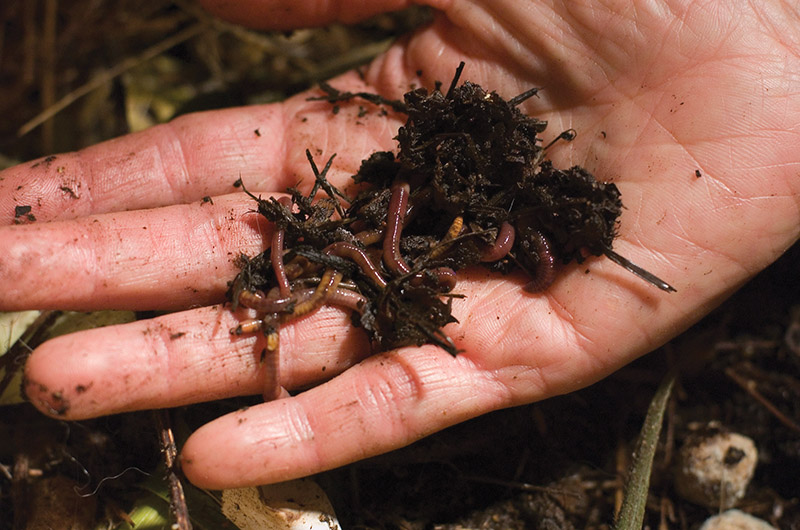Composting may seem like old news, but doing it with a bin full of worms probably doesn’t. Red wiggler worms offer great benefits to the organic gardener, producing both a natural fertilizer and an effective pesticide. And they eat your kitchen scraps.
The value of red wigglers, a.k.a. Eisenia fetida, lies in their excrement, known as worm castings. This brown, nutrient-rich organic fertilizer can be stirred into dirt to enrich the soil. Worm castings may be purchased at stores such as SBS in Vineyard Haven or Vineyard Gardens in West Tisbury, but to raise the worms in a compost bed and harvest your own castings is much more fun. The work of these worms is an element of sustainable living.
Red wigglers are indigenous to horse manure, where they burrow to lay eggs. Generally though, the wigglers live on the surface of the soil or compost, recycling food scraps in a process known as vermicomposting. The worms’ digestive process converts discarded leaves and vegetables into castings. The high-quality humus resembles nothing more than dirt, and works as an additive to indoor or outdoor organic gardens.
Sustainable-living ventures such as the Community Solar Greenhouse (COMSOG) in Oak Bluffs have worm bins on their premises. COMSOG is a collection of like-minded gardeners who raise organic plants. “The worms feed on rotten melons, lettuce, and leaves, so the bins are filled with composting garbage, which is heaven from a worm’s perspective,” says avid COMSOG gardener Lynn Thorp, who lives in Oak Bluffs. “They love melon rinds,” she adds, “and the juicier the better.”
Chuck McBride, of Oak Bluffs, is the manager of COMSOG and mans the worm bins, which are basically a couple of plastic dishpans. The worms crawl around, wriggling away when exposed to sunlight. “They’re shy little monkeys,” says Chuck as he pokes at the moist worm castings, which settle at the bottom of the bin. “It’s precious. They can’t make a lot of it.” He covers the bin with straw, then a piece of old carpet. “They like the warmth,” he says.
Lynn explains the production of castings and two uses: as a fertilizer and as a pesticide. “They digest rotting matter. It passes through them and adds calcium to make this rich earth,” she says. “I use just a handful to put in flower pots. It doesn’t make monster amounts.” These are small worms. When Lynn repotted her violets in soil strengthened by worm castings, it “produced gorgeous flowers. They really made a difference.” She says red wigglers thrive in a small organic compost pile, as well as more commercial ventures such as COMSOG.
The castings can also be used to make a pesticide: Pour a scoop of worm castings into an old sock, soak the sock in a cupful of water, then hold it up to let the nutrients drain into the cup. The liquid can be sprayed on outdoor and indoor plants to eliminate pests.
“We call it golden tea,” says Lynn. “I did it to see if it would make a difference on white flies and aphids. My rosemary had a mold or fungus. After I sprayed, immediately it looked better.”
The red wiggler is a prodigious breeder, laying eggs as often as once a week. Eggs hatch at a temperature between 65 and 85 degrees, and two to four tiny worms emerge from each egg – and go to work. It takes three to five months for a baby worm to reach sexual maturity and the adult length of three inches.
Their life span is four to five years – unless of course they are used for bait. As freshwater fish bait, wigglers squirm on the hook and survive underwater longer than conventional earthworms. They also are more resistant to heat and light than common night crawlers. (Since there’s more saltwater fishing on the Vineyard, they aren’t popular bait here.)
These worms have other applications too. South Mountain Company in West Tisbury uses red wigglers as an additive to help speed up the process in the composting toilets at Island Cohousing in West Tisbury. Laurel Wilkinson, who lives on-site and works at South Mountain, says, “If there’s a good colony of worms, things are getting broken down as they should.”
Dr. Barbara Stelle, a neurologist, raises red wiggler worms too. Several years ago the Stelle family moved into an Edgartown fixer-upper farm. “I wanted to get into farming with things that didn’t need to be tended to everyday like a cow. We were introduced to worm farming and started with 50,000 worms. That sounds like a lot, but they’re very small.”
She initially purchased her worms online from a worm farm in Vermont. More recently, she’s dealt with Maggie Pipkins at the Cape Cod Worm Farm in Buzzards Bay; the cost was about $25 per pound – roughly a thousand worms.
For home gardeners, Barbara suggests beginning with the worms in a dishpan-size container; as they multiply, they can be transferred into a compost pile. Barbara says it’s hard to kill them and they stay in the compost; they don’t crawl away. When the Stelles recently moved to Vineyard Haven, Barbara brought several worm bins along and keeps them under her deck. She continues to be an advocate of red wigglers: “Nature sure made an efficient machine. All these worms do is eat, poop, and reproduce.”





